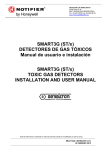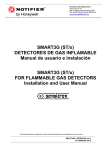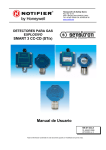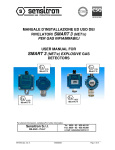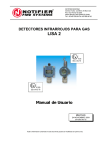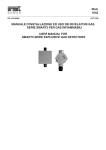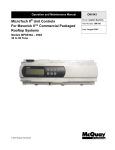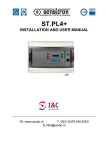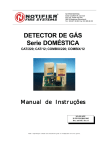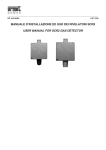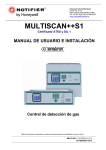Download Smart3G gas tossici
Transcript
SMART3G MANUALE D'INSTALLAZIONE E USO INSTALLATION AND USER MANUAL SMART3G (ST/x) RIVELATORI PER GAS TOSSICI MANUALE D’INSTALLAZIONE ED USO SMART 3G (ST/x) TOXIC GAS DETECTORS INSTALLATION AND USER MANUAL SENSITRON S.r.l. Viale della Repubblica, 48 20010 CORNAREDO MI - Italy Ph: + 39 02 93548155 Fax: + 39 02 93548089 E-MAIL: [email protected] MTEX2785 rev2.doc 16/10/2012 Pag. 1/20 SMART3G MANUALE D'INSTALLAZIONE E USO INSTALLATION AND USER MANUAL Attenzione Warning QUESTO MANUALE DEVE ESSERE LETTO ATTENTAMENTE DA TUTTI COLORO CHE HANNO O AVRANNO LA RESPONSABILITA' DI INSTALLARE, UTILIZZARE O DI PRESTARE UN SERVIZIO DI ASSISTENZA SU QUESTO PRODOTTO. THIS MANUAL MUST BE CAREFULLY READ BY ALL PERSONS WHO HAVE OR WILL HAVE THE RESPONSIBILITY FOR INSTALLING, USING OR SERVICING THIS PRODUCT. Come ogni componente di un sistema, questo prodotto funzionerà correttamente solo se installato, utilizzato e controllato come prescritto dal fabbricante. IN CASO CONTRARIO, POTREBBE NON FUNZIONARE CORRETTAMENTE E LE PERSONE CHE AFFIDANO LA LORO SICUREZZA A QUESTO PRODOTTO POTREBBERO SUBIRE DANNI PERSONALI O LETALI. Like any equipment, this product will perform as designed only if installed, used and serviced in accordance with the manufacturer’s instructions. OTHERWISE, IT COULD FAIL TO PERFORM AS DESIGNED AND PERSONS WHO RELY ON THIS PRODUCT FOR THEIR SAFETY COULD SUFFER SEVERE PERSONAL INJURY OR DEATH. La garanzia riconosciuta da Sensitron s.r.l. su questo prodotto potrebbe essere nulla se il prodotto non venisse installato, utilizzato e controllato secondo le istruzioni fornite con il presente manuale. Per favore, proteggetevi seguendole attentamente. The warranties made by Sensitron s.r.l. with respect to this product are voided if the product is not installed, used and serviced in accordance with the instructions in this user guide. Please protect yourself and others by following them. Invitiamo i nostri clienti a scriverci o a chiamarci per ogni informazione riguardo questo strumento, il suo uso o una sua eventuale riparazione. We recommend our customers to write or call regarding this equipment prior to use or for any additional information relative to use or repair. Per i clienti che hanno acquistato uno dei seguenti rilevatori: S2170SD, S2172ND, S2174CL, S2171SD, S2173ND, S2175CL, S2311HC, S2139SD, S2141ND, S2143CL, S2147HC, S2138SD, S2140ND o S2142CL, si prega di leggere e seguire attentamente il paragrafo 3.7 Collegamento a terra della sicurezza intrinseca (solo per i prodotti a SI) For costumers that have purchased one of the following detector models: S2170SD, S2172ND, S2174CL, S2171SD, S2173ND, S2175CL, S2311HC, S2139SD, S2141ND, S2143CL, S2147HC, S2138SD, S2140ND or S2142CL, please make sure to read and follow paragraph 3.7 Ground connection of the intrinsic safety (only for intrinsically safe products). MTEX2785 rev2.doc 16/10/2012 Pag. 2/20 SMART3G MANUALE D'INSTALLAZIONE E USO INSTALLATION AND USER MANUAL INDICE / INDEX 1 1 INTRODUZIONE ................................................................................................................................................................ 4 INTRODUCTION ................................................................................................................................................................ 4 1.1 Descrizione ................................................................................................................................................................ 4 1.1 Description ................................................................................................................................................................. 4 1.2. Identificazione rivelatore gas tossici ........................................................................................................................... 5 1.2. Toxic gas detectors identification................................................................................................................................ 5 1.3 Caratteristiche tecniche .............................................................................................................................................. 6 1.3 Technical specifications ............................................................................................................................................. 6 2 PREDISPOSIZIONE DEL SITO D’INSTALLAZIONE ......................................................................................................... 7 2 INSTALLATION SITE PREARRANGEMENT ..................................................................................................................... 7 3 INSTALLAZIONE ............................................................................................................................................................... 8 3 INSTALLATION ................................................................................................................................................................. 8 3.1 Modalità per il corretto montaggio .............................................................................................................................. 8 3.1 Correct positioning mode ........................................................................................................................................... 8 3.2 Schema topografico circuito ....................................................................................................................................... 8 3.2 Detector circuit layout ................................................................................................................................................. 8 3.3 Configurazione del rivelatore ............................................................................................................................................. 9 3.3 Detector configuration ....................................................................................................................................................... 9 4 4 5 5 3.4 Collegamento con uscita 4-20mA ............................................................................................................................. 10 3.4 4-20mA output connection ....................................................................................................................................... 10 3.5 Collegamento uscita seriale RS485 (optional) .......................................................................................................... 11 3.5 RS485 serial output connection (optional) ................................................................................................................ 11 3.6 Collegamento con schede opzionali ......................................................................................................................... 12 3.6 Connection to optional boards .................................................................................................................................. 12 3.7 Collegamento a terra della sicurezza intrinseca (solo per i prodotti a sicurezza intrinseca) ...................................... 13 3.7 Ground connection of the intrinsic safety (only for intrinsically safe products) ........................................................... 13 COLLAUDO E USO ......................................................................................................................................................... 17 TESTING AND USE ......................................................................................................................................................... 17 4.1 Accensione .............................................................................................................................................................. 17 4.1 Power ON ................................................................................................................................................................ 17 4.2 Collaudo................................................................................................................................................................... 17 4.2 Testing ..................................................................................................................................................................... 17 4.3 Uso .......................................................................................................................................................................... 17 4.3 Use .......................................................................................................................................................................... 17 MANUTENZIONE ............................................................................................................................................................. 18 MAINTENANCE ............................................................................................................................................................... 18 5.1 Manutenzione preventiva ......................................................................................................................................... 18 5.1 Preventive maintenance routines................................................................................................................................... 18 5.2 Manutenzione correttiva ........................................................................................................................................... 18 5.2 Corrective maintenance routines .................................................................................................................................. 18 5.3 Istruzioni per la dismissione ..................................................................................................................................... 18 5.3 Disassembly instructions .......................................................................................................................................... 18 5.4 Ripristino dei dati ai valori di default ......................................................................................................................... 18 5.4 Data reset to default parameters .............................................................................................................................. 18 6. ISTRUZIONI PER L'IMBALLAGGIO ................................................................................................................................ 19 6. PACKING INSTRUCTIONS .............................................................................................................................................. 19 7 ACCESSORI .................................................................................................................................................................... 19 7 ACCESSORIES................................................................................................................................................................ 19 8 TAGLIANDO DI GARANZIA PER LA RIPARAZIONE ..................................................................................................... 20 8 WARRANTY COUPON FOR REPAIRING ....................................................................................................................... 20 MTEX2785 rev2.doc 16/10/2012 Pag. 3/20 SMART3G MANUALE D'INSTALLAZIONE E USO 1 1.1 INSTALLATION AND USER MANUAL INTRODUZIONE 1 Descrizione 1.1 INTRODUCTION Description I rilevatori di gas della serie SMART3G sono un'evoluzione della precedente versione SMART 3C. Gli SMART3G possono essere collegati sia a centrali di tipo analogico sia indirizzate, nonché alle centrali di nuova concezione MULTISCAN++. Gas detectors series SMART3G are an evolved version of the SMART3C line. The SMART3G can be connected to both analog and addressable control panels as well as with the new MULTISCAN++. Le celle elettrochimiche utilizzate per i gas tossici consentono ai rilevatori di rilevare la presenza di sostanze tossiche in ppm e in % volume per l'ossigeno. Per la rivelazione della CO2 viene utilizzato un sensore infrarosso che offre un accurata misura sia per valori in ppm sia in %volume fino al 30%vol. The electrochemical cells employed for the detection of toxic gases allow SMART3 detectors the measurement of toxic compounds in ppm values and % by volume for O2. For the CO2 detection, an Infrared sensor is being employed to offer accurate reading from ppm up to 30% vol. Il rilevatore fornisce un'uscita proporzionale in corrente (420 mA) corrispondente a: - 0-100% del fondo scala dichiarato sul rivelatore con lettura in ppm (parti per milione). - 0-25% oppure 0-30% volume per ossigeno. - 0-2%, 0-5% e 0-30% volume per l'anidride carbonica The detector offers a proportional output current (4-20mA) corresponding to: - 0-100% of the full scale in ppm (part per million) stated on the detector. - 0-25% or 0-30% by volume for oxygen. - 0-2%, 0-5% e 0-30% by volume for carbon dioxide. Il microprocessore presente sulla scheda elettronica del rivelatore, oltre che per il normale funzionamento, è provvisto dei seguenti algoritmi software che servono per aumentare l’accuratezza del rilevatore: Autodiagnosi del sistema, che verifica costantemente il corretto funzionamento dell’hardware, sensore compreso. Inseguitore di Zero per il mantenimento del parametro del sensore prescindendo da possibili derive dovute a variazioni termiche o fisiche del sensore stesso. Filtro digitale che consente di correggere fenomeni transitori che potrebbero causare una instabilità del sistema o errori di lettura con conseguenti falsi allarmi; Ciclo d’isteresi viene applicato alle uscite digitali associate alle soglie d’allarme e consente l’eliminazione delle continue commutazioni nell’intorno dei punti di soglia. Watch-dog per il controllo del microprocessore. In caso di intervento la corrente di uscita viene forzata a 0mA e il LED rosso di segnalazione resta acceso. Se sul rilevatore è presente la scheda seriale RS485, la trasmissione viene interrotta, mentre se è installata la scheda 3 relè, il relè di fault si attiva. To protect and increase the stability and accuracy of the gas detector, the microprocessor present on the internal electric circuit board, is programmed with the following software algorithms: Self diagnostic procedure to control the detector main operational parts, both hardware and sensing element. Zero point tracking to maintain the zero parameter of the sensor apart from possible drifts due to thermal or physical variations of the sensor. Digital filter employed in the digital analysis of the analogue values sampled. It is designed to prevent the effects of transients, which may cause instability or incorrect readings with possible false alarms. Hysteresis cycle applied to the digital outputs to eliminate continuous switching close to the preset alarm thresholds. Watch-dog for the microprocessor control. In case of intervention, the output current drops down to 0mA while the red LED stops blinking and remains on. If the RS485 interface is connected, the communication will be interrupted, while if the 3-relay card is plugged in, the Fault relay will activate. MTEX2785 rev2.doc 16/10/2012 Pag. 4/20 SMART3G MANUALE D'INSTALLAZIONE E USO 1.2. INSTALLATION AND USER MANUAL Identificazione rivelatore gas tossici MTEX2785 rev2.doc 1.2. 16/10/2012 Toxic gas detectors identification Pag. 5/20 SMART3G MANUALE D'INSTALLAZIONE E USO 1.3 INSTALLATION AND USER MANUAL Caratteristiche tecniche Elemento sensibile Corpo sensore (eccetto versione Gruppo I) Campo di misura Risoluzione Alimentazione Assorbimento a 12Vcc (senza display) Unità di controllo Segnalazioni luminose 1.3 Celle elettrochimiche Sensore IR per CO2 Certificato ATEX CESI 01ATEX013U o CESI 01ATEX066U 0-100% fondo scala Out analog 0,025 mA Display ±1% ±1 digit 12-24 Vcc -20% + 15% 90 mA medio 130 mA massimo Microprocessor 10 bit LED ad intermittenza Technical specifications Sensing element Sensor head (except Group I version) Measurement range Resolution Power supply Consumption at 12Vdc (without display) Control unit Visual indications (vedi par.4.3) Uscita proporzionale con jumper 5-6 chiuso (ref. Pag. 9) Uscita proporzionale con jumper 5-6 aperto (ref. Pag. 9) Resistenza di carico max Uscita digitale seriale (opzionale) Uscite relè con scheda STS3REL (opzionale) (see paragraph 4.3) 4-20 mA (default) 3mA allarme di underscale 2mA guasto 4-20mA 2mA guasto 22mA allarme overrange 200Ω RS485 per MULTISCAN++ e SENTOX IDI 3 relè con contatti in scambio liberi da tensione 24V-1 A. Proportional output with jumper 5-6 closed (refer page 9) Proportional output with jumper 5-6 open (refer page 9) Max. load resistance Serial Output (optional) 4-20 mA (default) 3mA under-scale alarm 2mA Fault 4-20mA 2mA Fault 22mA overrange alarm 200Ω RS485 for MULTISCAN++ and SENTOX IDI Relay outputs, with 3 relays with tension free STS3REL board (optional) changeover contact 24V-1 A (Relè non memorizzati) Procedura di auto zero Filtro digitale Risoluzione Display Precisione Tempo preriscaldamento Tempo stabilizzazione Tempo di risposta T90 (non latching relay) Compensazione delle derive di zero medie mobili sui valori acquisiti 1024 punti 4 digit luminosi ± 5% del fondo scala o 10% della lettura 2 minuti 60 minuti (per test/taratura) Da 15 a 30 secondi (dipende Auto zeroing routine Zero drift compensation Digital filter variable average on the sampled values 1024 dots 4 digits ±5% full scale value or 10% reading 2 minutes 60 minutes (for test/calibr.) From 15 to 30 secs Resolution Display Accuracy Warm-up time Stabilization time Response time T90 dal tipo di sensore) Ripetibilità (depending on sensor type) da ±2% a ±5% del FS Repeatability (dipende dal tipo di sensore) Temperatura di stock Temperatura operativa Umidità relativa Pressione di esercizio Velocità dell’aria Entrata cavi Peso Watch-dog Dimensioni Orientamento Electrochemical cells IR sensor for CO2 ATEX certificates CESI 01ATEX013U or CESI 01ATEX066U 0-100% full scale range Out analog 0,025 mA Display ±1% ±1 digit 12- 24 Vdc - 20% + 15% 90 mA medium 130 mA max Microprocessor 10 bit Flickering LED -25 / + 60 °C (o limiti del sensore) Come indicato sull'etichetta dello strumento 20-90 % Rh / 40° C (5-95% RH non condensante, a richiesta) 80-110 kPa < 6 m/sec 2 x ¾” NPT Exn: g 850 ÷ 1200 Exd: g 950 ÷ 1700 Interno per il controllo del microprocessore Exd: mm 130x90 h 180 Exn: mm 106x65 h180 Installazione verticale con sensore rivolto verso il basso from ±2% to ±5% FS (depending on sensor type) Storage temperature Operating temperature Relative humidity Operating pressure Air velocity Input cable Weight Watch-dog Dimension Positioning -25 / + 60 °C (or limits of the sensor) As stated on the detector's label 20-90 % Rh / 40° C (5-95% RH non condensing, on request) 80-110 kPa < 6 m/sec 2 x ¾” NPT Exn: g 900 ÷ 1150 Exd: g 1250 ÷ 1550 Internal, for the microprocessor status control Exd: mm 130x90 h 180 Exn: mm 106x65 h180 To be mounted sensor head downward Marcatura ATEX, Certificati Per spiegazioni sulla eventuale marcatura ATEX, certificati e e Norme ATEX marking, Certificates and Standards For information on ATEX marking, certificates and standards, please refer to the safety instructions supplied with the instrument Norme di riferimento EMC EMC Reference norms EN50270:1999 EN61000-6-3:01+A11:04 norme, vedere istruzioni di sicurezza fornite con lo strumento. MTEX2785 rev2.doc EN50270:1999 EN61000-6-3:01+A11:04 16/10/2012 Pag. 6/20 SMART3G MANUALE D'INSTALLAZIONE E USO 2 INSTALLATION AND USER MANUAL PREDISPOSIZIONE DEL SITO D’INSTALLAZIONE 2 INSTALLATION SITE PREARRANGEMENT Durante le operazioni di montaggio e installazione, gli impianti devono essere messi in sicurezza. Ricordiamo anche come in fase di installazione sia opportuno tenere in considerazione alcune norme generali in quanto un posizionamento non corretto può pregiudicare il funzionamento ottimale del rivelatore. Si raccomanda di non installare rivelatori gas nelle vicinanze di prese d’aria e/o ventilatori che provocano forti correnti d’aria. I rivelatori non devono essere altresì posti in zone nelle quali siano presenti vibrazioni e, sebbene immuni da disturbi a radiofrequenze è consigliabile non installarle in prossimità di emettitori radio (ponti radio o apparecchiature simili). Altra buona norma è quella di installare il rivelatore in zone facilmente accessibili per le operazioni di test e taratura e per l’inserimento dell’adattatore del kit di calibrazione. At the mounting and installation phase be sure all safety precautions have been considered. Always consider how important it is the correct positioning of gas detectors to get the optimum response. Be careful never to install gas detectors close to air intakes or fans causing strong air currents. Be sure the detectors are attached to a firm base to prevent vibration that can damage them, producing unreliable results. Although the electronics comply with the electromagnetic compatibility rules, it is advised to keep the detectors at a distance from any radio frequency senders (such as radio links or similar). Please be also sure that detectors are placed in a convenient location for future maintenance and calibration requirements I gas più leggeri dell’aria, disperdendosi nell’ambiente, tenderanno a salire verso l'alto; per ottenere un efficace intervento il rivelatore deve essere posizionato a 30 cm dal soffitto. I gas più pesanti dell’aria disperdendosi stazioneranno nella parte bassa dell’ambiente; il rivelatore deve quindi essere posizionato a 30 cm dal pavimento. Il monossido di carbonio, avendo un peso specifico circa uguale a quello dell’aria, può stazionare ad altezze non predefinite, quindi installare il rivelatore ad una altezza di circa 1.60 m. dal pavimento All of the gases lighter than air tend to spread upwards; the detector should be placed at 30 cm from the ceiling in order to maximise the effectiveness of the detection. All of the gases heavier than air tend to spread downwards; the detector should be placed at 30 cm from the floor. Carbon monoxide, having a specific weight approximately equal to air's should be detected at breathing level, and the detector should be at approximately 1.60 m above the floor to get a reliable protection. Vi sono alcune sostanze che, se presenti nell'atmosfera da monitorare, possono alterare considerevolmente la risposta del sensore. Allorché si presuma la presenza di queste sostanze, si consiglia di verificare frequentemente e sempre dopo ogni intervento degli allarmi, la sensibilità del rilevatore con gas di taratura. There are some substances that, when present in the atmosphere being monitored, can considerably change the response of the sensor. Whenever their presence is presumed, it is recommended to check the detector's with sample gas bottles at short time intervals, and always after an alarm intervention MTEX2785 rev2.doc 16/10/2012 Pag. 7/20 SMART3G MANUALE D'INSTALLAZIONE E USO INSTALLATION AND USER MANUAL 3 INSTALLAZIONE 3 INSTALLATION 3.1 Modalità per il corretto montaggio 3.1 Correct positioning mode Il rivelatore deve sempre essere installato con l’elemento sensibile (testa di rivelazione) rivolta verso il basso. Il contenitore del rivelatore, per nessuna ragione deve essere forato; per il fissaggio utilizzare i fori già esistenti. I rivelatori con protezione Exd sono forniti completi di staffa per fissaggio a muro. The gas detector is always to be mounted with the sensing element placed downward. For no reasons at all the enclosure can be drilled. Wall mount the detectors by employing the existing holes. Exd detectors come complete with wall fixing brackets. 3.2 3.2 Schema topografico circuito Circuito rivelatore SMART 3G Detector circuit layout Morsettiera di collegamento estraibile (Main plugin terminal board for connections) SMART 3G detector circuit Led di indicazione di stato (Status led indication) Connettore per (Plug in terminal for): - Scheda Rs485 o (RS485 board or) - Scheda a un rele o due open collector o (One relay or two open collector board or) DIP-SWITCH per selezionare le soglie (Thresholds setting point DIP-SWITCH) 1 2 3 4-20mA Uscita negativa “DEFAULT” (4-20 mA Negative output mode, default) 1 2 3 4-20mA Uscita positiva (4-20 mA Positive output mode) J11 Connettore per scheda display o relè (J11 Plug in connettor for display or relay board) Connessione elemento sensibile (Sensing element connection) Display optional board Fault lED Led di acceso (power on LED) LED Alarm 1 LED Alarm 2 LED Alarm 3 Display per indicazione della concentrazione di gas (Display for a gas concentration readout) Collegare a J11 (vedi sopra) (Connect to J11, see above) Scheda display opzionale MTEX2785 rev2.doc 16/10/2012 Pag. 8/20 SMART3G MANUALE D'INSTALLAZIONE E USO INSTALLATION AND USER MANUAL 3.3 Configurazione del rivelatore 3.3 Detector configuration Il rilevatore dispone di una uscita proporzionale 4-20mA. E' altresì possibile collegare i rivelatori in cascata su un bus RS485. In questo caso è necessario montare nei rivelatori l'interfaccia RS485 modello STS/IDI. The detector provides a 4-20mA proportional output. It is also possible to have detectors daisy chained on RS485 bus lines. In that case, it is necessary to have RS485 interface model STS/IDI mounted in the detector. E' possibile integrare nel rivelatore standard di uscita diversi, utilizzando le seguenti schede opzionali: STS1REL, scheda a 1 relè (relè non memorizzati) STS3REL, scheda a 3 relè (relè non memorizzati) STS/OC , scheda a 2 open collectors. It is possible to provide the detector with optional outputs by inserting the following optional cards: STS1REL, 1 relay board (non latching relay) STS3REL, 3-relay board (non latching relay) STS/OC, 2-open collector board Per il corretto funzionamento delle schede opzionali, è necessario aprire il jumper JP5-6 posizionato sulla scheda base. To activate the outputs provided by the above boards, it is necessary to open the jumper JP5-6 on the main PCB. NB.: Se non viene aperto il ponticello JP5-6 non sarà possibile collegare le schede opzionali di uscita perché, con il concetto SIL introdotto dalle nuove centrali, tutta la parte di attivazioni e blocchi è demandata alla centrale: il rivelatore SMART3G si limita a rilevare la concentrazione di gas e a trasferirla alla centrale. N.B.: If the jumper JP5-6 is not opened, it won't be possible to connect the above optional output boards because, with the new SIL concept available in the new panels, all the activation and deactivation procedures are made by the control panels: SMART3G detectors are just required to detect gas contents and transfer these data to the panel. Back-up Dati di configurazione Configuration data back-up Uscita 4-20mA nella configurazione di default 4-20mA output as per default configuration Underscale 3mA Underscale 3mA Guasto 2mA Fault 2mA (necessaria per il collegamento dei rivelatori alle centrali MULTISCAN++) (required for the connection of gas detector sto MULTISCAN++ control panels) 4-20mA tradizionale Analog 4-20mA Guasto 2mA Fault 2mA Overrange 22mA Overrange 22mA JP5-6 JP5-6 Aperto / Open Chiuso / Closed SI / YES SI / YES -- SI / YES SI / YES -- Collegamento schede opzionali Connection to optional cards SI / YES -- Visualizzazione LED su scheda display LED visualization on display board SI / YES -- Collegamento Scheda RS485 Connection to RS485 inteface SI / YES SI / YES MTEX2785 rev2.doc 16/10/2012 Pag. 9/20 SMART3G MANUALE D'INSTALLAZIONE E USO 3.4 INSTALLATION AND USER MANUAL Collegamento con uscita 4-20mA 3.4 4-20mA output connection Il rilevatore viene configurato per avere di default una uscita proporzionale 4-20mA. Per il collegamento del rivelatore con la centrale e alimentazione si raccomanda l'uso di cavo schermato. La sezione del cavo da utilizzare dipende dalla distanza del rilevatore dalla centrale: -per distanze inferiori a m 100 si usino cavi con sezione di 2 0.75 mm ; -per distanze comprese fra m 100 e 200 si usino cavi con 2 sezione di 1.0 mm ; -per distanze comprese fra m 200 e 300 si usino cavi con 2 sezione di 1.5 mm . Nel caso vi siano giunzioni nel cavo di collegamento, assicurarsi che vi sia continuità anche sulla schermatura dei cavi. Ricordasi che la schermatura deve essere collegata a terra unicamente dal lato dalla centrale, mentre non dovrà mai essere collegata sui rilevatori. Assicurarsi che la realizzazione di giunzioni sui cavi di alimentazione mediante dispositivi di serraggio o a crimpare, sia eseguito a regola d’arte con capicorda e/o morsetti che nel tempo non si ossidino o allentino. E’ sempre preferibile eseguire giunzioni saldate. I rilevatori SMART3G possono essere collegati a centrali di rivelazione gas di altre marche, purché in grado di leggere un segnale 4-20mA. Si raccomanda di accertarsi che le centrali siano certificate in conformità alle norme EN60079-29-1. The default configuration provides a 4-20mA proportional output Wiring between the detector and the control panel should be carried out with shielded cables. Wires' cross section depends on the distance between the control panel and the detector: -for a distance up to m 100 we advice a 3 core wire with 2 cross section area of 0.75 mm ; -for a distance between m 100 and 200 we recommend a 2 3 core wire with cross section of 1.0 mm ; -for a distance between m 200 and 300 we recommend a 2 3 core wire with cross section 1.5 mm . Should any junctions be necessary on wires, please make sure there is no interruption on the shield. SCHEMA COLLEGAMENTO per 4-20 mA 4-20 mA CONNECTION SCHEME Nello schema seguente viene riportato il tipico collegamento di un rilevatore SMART3G ad una centrale SENSITRON tipo PL4+ o MULTISCAN ++ ecc. The following drawing shows the connection of a SMART3G detector to a SENSITRON's control panel like PL4+ or MULTISCAN++ etc. N.B.: Nel caso di centrali con ingresso 4-20 mA, è possibile collegare 1 solo rilevatore a ciascun ingresso. N.B.: Control panels accepting 4-20mA input signals allow the connection of only one detector per input. MTEX2785 rev2.doc Please remember that the shield is to be grounded from the control panel side only. Also remember never to connect the shield to the detectors. Ensure the wire connections, either clutching or crimping type, are properly carried out with terminals that do not oxidise or loosen. We recommend having them soldered. The SMART3G gas detectors can be connected to control panels available on the market having 4-20mA input signals. Please make sure the panels are certified according to the standards EN60079-29-1.. 16/10/2012 Pag. 10/20 SMART3G MANUALE D'INSTALLAZIONE E USO INSTALLATION AND USER MANUAL 3.5 Collegamento uscita seriale RS485 (optional) 3.5 RS485 (optional) Per utilizzare i rivelatori SMART3G su bus RS485, è necessario montare nei rivelatori l'interfaccia RS485 modello STS/IDI. Per il collegamento dei rivelatori su bus RS485 sono necessari 4 conduttori, 2 di alimentazione e due per la linea seriale RS485. Il collegamento dei rivelatori alla centrale, deve essere realizzato con cavo per connessioni EIA RS 485: n.2 conduttori con sezione 0,22 / 0,35 mmq + schermo (coppia twistata). Capacità nominale tra i conduttori <50 pF/m, impedenza nominale 120 ohm. Un tipo di cavo di esempio e' il BELDEN 9842 o similare (cavo per trasmissione dati in EIA RS485). Con questo tipo di collegamento la lunghezza totale della linea non può superare i m 1000. Collegare i rivelatori solo in modalità “cascata”. Si raccomanda di evitare collegamenti ad albero o a stella in quanto riducono l’immunità alle interferenze. Verificare altresì che ciascun cavo multipolare contenga un solo RS485. In uscita dalla centrale e sull’ultimo rivelatore/modulo della catena dovrà essere posta la resistenza di chiusura linea da 120 Ohm. Per la connessione dell’alimentazione ai rilevatori, raccomandiamo di utilizzare un cavo di sezione adeguata, in base alla distanza ed al numero di rivelatori della linea. Ad installazione eseguita, controllare che tutti i rilevatori installati ricevano una tensione minima di 12 Vdc. Quando la scheda STS/IDI è inserita, i dip-switch presenti sulla scheda base dello SMART3G servono per stabilire l’indirizzo del rilevatore. Le soglie di allarme si imposteranno automaticamente alla configurazione di default; per esigenze particolari contattare il fornitore. Utilizzando la RS485 l’uscita proporzionale 4-20mA rimane attiva. Per configurare gli indirizzi dei rivelatori consultare il manuale fornito con la scheda STS.IDI To connect SMART3G gas detectors to RS485 bus lines, it is necessary to have the RS485 interface model STS/IDI plugged in the detectors. The connection of SMART3G to RS485 bus lines should be performed by using a 4-wire cable, 1 pair for the RS485 bus and 1 for the power supply. Wiring between the detectors and the control panel should be made by using connection cable EIA RS485: 2 2 core wires with section 0.22 / 0.35 mm and shield (twisted pair). Nominal capacity between the wires <50pF/m, nominal impedance 120 ohm. These features can be found in BELDEN cable 9842 or similar (data transmission cable in EIA RS485). Using this wiring, the total length of the line should not exceed m 1000. Detectors and output modules are to be wired in daisy chain mode. We recommend avoiding star or tree mode connection as interference immunity would be reduced. Make sure that each multi-polar wire includes just one RS485. Make sure that a 120 Ohm end line resistor is placed at the beginning and at the end (on the last detector or output module) of the bus line. For the detectors' power supply connection we recommend to use a 2-wire cable with suitable section according to the distance and number of detectors. Once the installation has been completed, verify that each detector reaches at least 12 Vdc. When the STS/IDI board is plugged in, the dip-switches on SMART3G motherboard are employed to set the detector address. Alarm thresholds will automatically set on the default configuration. For particular needs please contact the supplier. When detectors are RS485 connected, the proportional 420mA output remains active. To set the detectors' address, please refer to the technical handbook of STS.IDI interface MTEX2785 rev2.doc 16/10/2012 serial output connection Pag. 11/20 SMART3G MANUALE D'INSTALLAZIONE E USO 3.6 INSTALLATION AND USER MANUAL Collegamento con schede opzionali Aprendo jumper JP5-6 posizionato sulla scheda base è possibile attivare il funzionamento delle uscite opzionali offerte dalle seguenti schede: -ST.S3REL, scheda dotata di 3 relè con contatti puliti liberi da tensione. Un relè è associato all'uscita di Fault e watch-dog mentre gli altri due possono essere associati a due delle tre soglie di allarme presenti. -ST.S1REL, scheda a 1 relè che permette di ottenere un’uscita con contatto pulito libero da tensione degli stati di Allarme e/o Guasto del rivelatore. -STS/OC, scheda con 2 uscite Open Collector Configurando diversamente i dip-switch presenti sulla scheda base si possono modificare le soglie di allarme. Anche disponendo della scheda opzionale a 3 relè è possibile modificare le soglie di intervento dei relè come indicato nella tabella seguente. 3.6 Connection to optional boards By opening the JP5-6 jumper on the main PCB, it is possible to activate optional outputs available when using the following cards: -ST.S3REL, three-relay card with tension free changeover contacts. One relay is associated to Fault and Watch-dog. The remaining two are to be associated to two outputs of the three preset alarm thresholds. -ST.S1REL, one-relay card to offer one tension free changeover contact, to be either associated to Fault or to Alarm status. -STS/OC, 2 open collector card By modifying the dipswitch configuration on the motherboard, different alarm thresholds might be obtained. It is also possible to modify the relay intervention when using the 3-relay card, as per the following table PROGRAMMAZIONE JUMPERS PER SOGLIE DI ALLARME / JUMPERS PROGRAMMING FOR ALARM THRESHOLDS CUSTOM 15 25 40 (*) 22 23 24 NOT USED 3 5 10 10 15 30 15 30 45 5 10 15 10 20 30 25 35 50 (*) 20 19 18 5 10 20 10 25 35 20 40 60 (*) 19 18 17 IL DIP SWITCH N.2 SELEZIONA LA MODALITA’ DELL’USCITA IN CORRENTE DIP SWITCH N.2 SELECTS THE CURRENT OUTPUT MODE MTEX2785 rev2.doc 10 15 25 POSIZIONE “ON”: USCITA ANALOGICA PROPORZIONALE 4-20 mA CORRISPONDENTE ALLO 0-100% DEL FONDO SCALA “ON” POSITION: PROPORTIONAL ANALOG 4-20 mA OUTPUT CORRESPONDING TO 0-100% FULL SCALE POSIZIONE “OFF”: USCITA DOPPIA SOGLIA 10-20 mA PER CENTRALI A VARIAZIONE DI ASSORBIMENTO (LE SOGLIE OPERATIVE SONO LA 1 E LA 2). “OFF” POSITION: 10-20 mA CURRENT OUTPUT TO OPERATE WITH FIRE CONTROL PANELS USING A CURRENT/VOLTAGE CONVERSION (THE OPERATIVE THRESHOLDS ARE THE 1ST AND THE 2ND). 16/10/2012 Pag. 12/20 SMART3G MANUALE D'INSTALLAZIONE E USO INSTALLATION AND USER MANUAL 3.7 Collegamento a terra della sicurezza intrinseca (solo per i prodotti a sicurezza intrinseca) 3.7 Ground connection of the intrinsic safety (only for intrinsically safe products) Per i rilevatori dotati di testa-sensore a sicurezza intrinseca (vedi tabella sottostante) è estremamente importante che il collegamento a terra della custodia sia eseguito con particolare attenzione e cura. Un errato collegamento potrebbe danneggiare il fusibile interno e causare una rottura della barriera a sicurezza intrinseca. For detectors with intrinsically safe sensor heads (see table with product part numbers below), it is extremely important that the ground connection of the detector enclosure is performed with particular attention and accuracy. A faulty connection could blow the internal circuit fuse and lead to a rupture of the intrinsically safe barrier. Quando il rivelatore con la testa a sicurezza intrinseca è collegato a terra, le regole elencate qui di seguito devono essere osservate: When the detector with intrinsically safe sensor head is to be connected to the ground, the following rules must be followed: I cavetti marroni del circuito a sicurezza intrinseca posti all'interno del rivelatore devono essere collegati al sistema di equipotenzialità seguendo il più breve percorso possibile. Per i sistemi TN-S, i cavetti marroni devono essere collegati a un punto di terra di alta qualità, in modo da garantire che l’impedenza dal punto di collegamento fino al punto di messa a terra del sistema di alimentazione principale sia inferiore a 1 . Ciò può essere realizzato con il collegamento ad una sbarra di terra (collettore) nella cabina elettrica, o impiegando picchetti di terra separati. Deve essere usato un conduttore di terra isolato per impedire la dispersione verso terra delle correnti di guasto attraverso le parti metalliche con cui il conduttore potrebbe venire in contatto (per esempio telai dei quadri di comando). Il conduttore di terra deve essere protetto meccanicamente nei luoghi dove il rischio di danneggiamenti meccanici è elevato. La sezione del collegamento di terra deve essere ottenuta per mezzo di almeno due conduttori distinti 2 di rame, ciascuno di sezione minima 1,5 mm oppure almeno un conduttore in rame di sezione 2 minima di 4 mm . E' importante controllare regolarmente che il collegamento a terra sia libera da disturbi e che l'impedenza resti inferiore a 1 . Se il collegamento di terra viene eseguito tramite scatole di giunzione, fare particolare attenzione e verificare l’integrità della connessione. Vedi Norma EN 60079-14 per informazioni dettagliate riguardo i collegamenti di dispositivi a sicurezza intrinseca. MTEX2785 rev2.doc 16/10/2012 The two brown (ground) wires of the intrinsically safe circuits inside of the detector enclosure need to be connected to an equipotential bonding system by the shortest practicable route. For TN-S systems only, the brown wires are to be connected to a high integrity earth point in such a way as to ensure that the impedance from the point of connection to the main power system earth point is less than 1 . This may be achieved by connection to a switch room earth bar or by the use of separate earth rods. The conductor used shall be insulated to prevent possible cross-connections and contamination of the earth by fault currents which might flow in metallic parts the conductor could come into contact with (for example control panel frames). The ground conductor shall also be mechanically protected in places where the risk of damage is high. The cross-section of the earth connection shall be at least two separate copper conductors each with a 2 minimum cross section of 1,5 mm or at least one copper conductor with a minimum cross section of 4 2 mm . It is important to check regularly that the ground connection remains uncontaminated and that the impedance is less than 1 . If the earth connection is achieved via junction boxes, special care should be taken to ensure the continued integrity of the connection. See EN 60079-14 for detailed instructions on how to connect intrinsically safe devices. Pag. 13/20 SMART3G MANUALE D'INSTALLAZIONE E USO INSTALLATION AND USER MANUAL MTEX2785 rev2.doc SMART3G gas detector with Intrisically safe sensor head Elenco rilevatori SMART3G dotati di testa a sicurezza intrinseca Ci sono pertanto due possibili metodi per collegare i rivelatori a terra, a seconda della centrale di controllo utilizzata e delle caratteristiche dell'impianto There are accordingly two possible ways to connect the detectors to the ground, depending on the type of control panel used and the characteristics of the plant. Codice prodotto Modello SMART3G Part number SMART3G model Gas S2170SD G-D3, Ex n SO2 S2172ND G-D3, Ex n NO2 S2174CL G-D3, Ex n Cl2 S2171SD G-D2, Ex d SO2 S2173ND G-D2, Ex d NO2 S2175CL G-D2, Ex d Cl2 S2138SD G-C3, Ex n SO2 S2140ND G-C3, Ex n NO2 S2142CL G-C3, Ex n Cl2 S2139SD G-C2, Ex d SO2 S2141ND G-C2, Ex d NO2 S2143CL G-C2, Ex d Cl2 16/10/2012 Pag. 14/20 SMART3G MANUALE D'INSTALLAZIONE E USO INSTALLATION AND USER MANUAL Metodo d'installazione n. 1: Collegamento del rivelatore alla terra della centrale di controllo o del sistema di alimentazione principale Installation mode 1: Connect the detector to the ground of the control panel or of the main power system Raccomandato qualora la centrale o il sistema di alimentazione principale sia equipaggiata con un collegamento di terra dedicato per strumentazione a sicurezza intrinseca. This method is to prefer when the control panel/main power system is equipped with dedicated ground connections for the intrinsically safe detector heads. Allacciare il cavo di terra (assicurarsi di seguire le regole indicate precedentemente) al collegamento a terra della centrale/sistema di alimentazione principale e tirarlo fino al rivelatore. Assicurarsi che l'impedenza che l'impedenza tra il punto di collegamento alla terra del sistema di alimentazione sia inferiore a 1. Attach the ground conductor (make sure to follow the rules here above) to the dedicated ground of the control panel/main power system and wire it all the way to the detector. Make sure that the impedance from the point of connection to the main power system earth point is less than 1 . Togliere il coperchio del rivelatore e far entrare il cavo di terra (che arriva dalla centrale/dal sistema di alimentazione principale) dal passacavo posto nella parte superiore della custodia insieme agli altri cavi. Collegare il cavo di terra alla vite di terra interna (vedere illustrazione qui di seguito). Remove the detector's cover and lead the grounding conductor arriving from the control panel/main power system through the hole on the top of the detector, together with the other conductors. Connect the grounding conductor to the internal grounding screw (see figure below). Installation mode 1 MTEX2785 rev2.doc 16/10/2012 Pag. 15/20 SMART3G MANUALE D'INSTALLAZIONE E USO INSTALLATION AND USER MANUAL Metodo d'installazione n. 2: Collegamento del rivelatore alla terra ad alta integrità locale Installation mode 2: Connect the detector to a high integrity local ground Se il sistema di alimentazione principale/la centrale utilizzato non è provvisto di un collegamento dedicato di messa a terra per la sicurezza intrinseca, il rivelatore andrà collegato ad una terra ad alta integrità tramite la vite di terra posta nella parte superiore della custodia del rivelatore (vedi figura qui sotto). Assicurarsi che l'impedenza tra il punto di collegamento sulla custodia e il punto di riferimento del sistema equipotenziale ad alta integrità (sito normalmente in sala controllo) sia inferiore a 1 e che il cavo conduttore soddisfi i requisiti elencati in precedenza. If the main power system/control panel is not equipped with special dedicated ground connections used for intrinsically safe systems, then the detector needs to be connected to an high integrity ground through the grounding screw on the top of the enclosure of the detector (see figure below). Make sure that the impedance from the point of connection to the detector housing to the high integrity earth point of the equipotential system (normally situated in the switch room) is less than 1 and that the conductor fulfils the requests listed above. Installation mode 2 MTEX2785 rev2.doc 16/10/2012 Pag. 16/20 SMART3G MANUALE D'INSTALLAZIONE E USO INSTALLATION AND USER MANUAL 4 COLLAUDO E USO 4 TESTING AND USE 4.1 Accensione 4.1 Power ON Al momento in cui il rivelatore viene alimentato, si accende, ad intermittenza lenta il LED rosso sulla scheda base. L’uscita in corrente è 1,5 mA circa. Trascorsi 2 minuti circa, il LED rosso lampeggia con una frequenza pari allo stato in cui si trova il rilevatore (vedere tabella al punto 4.3) e l’uscita in corrente è a 4,0mA. Terminata la fase di preriscaldamento il rivelatore è in grado di funzionare correttamente, anche se sono comunque necessarie 2 ore circa affinché il rilevatore raggiunga le prestazioni ottimali. Se il rivelatore è provvisto di scheda display, consultare il manuale aggiuntivo fornito con gli SMART3G-D When the detector is powered on, the red LED on the motherboard starts blinking at slow intermittence. Output current is nearly 1.5 mA. After nearly two minutes, the red LED flash rate is equivalent to the detector working status (see table on paragraph 4.3) and the output current is 4.0mA. Once the warm-up phase is over, the detector can work correctly, although the optimal performances will be achieved after two hours. Should the detector be provided with display, please refer to the additional technical handbook supplied along with the SMART3G-D. 4.2 4.2 Collaudo Testing Il rilevatore viene tarato in fabbrica per il gas specificamente richiesto dal cliente. Successivamente è possibile controllare e eventualmente correggerne la taratura utilizzando l’apposita tastiera di calibrazione. Verificare la risposta del rivelatore utilizzando una miscela a composizione nota gas/aria, e l'apposito KIT di taratura. Vedi paragrafo 7 per ulteriori dettagli Detectors are factory calibrated for the specific gas required by the customers. Future adjustment of the preset calibration can be carried out by employing the calibration keypad. Testing should be carried out by using a gas mixture in the appropriate range, along with our calibration kit. See paragraph 7 for more details 4.3 4.3 Uso Il rivelatore funziona automaticamente e autonomamente, pertanto non è richiesto alcun contributo da parte del suo utilizzatore. Il LED rosso lampeggiante posto sulla scheda base del circuito indica lo stato in cui il rilevatore si trova come illustrato nella tabella sottostante. Assicurarsi che la segnalazione dello stato di overrange del rivelatore venga prevista, come indicato dalla norma EN60079-29-1:2007, paragrafo 5.4.18 Use The detector works autonomously and automatically. Once adequately connected, no further operations are required. The flashing red LED on the motherboard indicates the detector's working condition as detailed in the following table. Make sure the overrange status of the detector is indicated or signalled, as clearly defined by the standard EN60079-29-1:2007 paragraph 5.4.18. Frequenza lampeggio in secondi con il jumper JP5-6 Flash rate in seconds with jumper JP5-6 open aperto (default) (default configuration) Significato Meaning Tempo pre-riscaldo 1 ON – 0,1 OFF Warm-up time Normale funzionamento 1 ON - 1 OFF Normal mode Guasto - W.D. ON Fault - W.D. Mantenendo il jumper JP5-6 in posizione chiuso, se la concentrazione di gas misurata supera il 100% LEL, il LED sul circuito stampato si accende come per segnalare il fault, mentre sul display vengono attivate tutte le segnalazioni LED; l’uscita viene forzata a 22 mA. Per ripristinare il corretto funzionamento del rivelatore si dovrà togliere e ridare alimentazione With the JP5-6 jumper closed, should the measured gas concentration exceed 100% LEL, the red LED on the PCB lights up, as to signal the FAULT status, while on the display all of the LEDs light-up; output current will be forced to 22 mA. To reset the detector to normal working conditions it will be necessary to turn the power of the unit off and on. Frequenza lampeggio in secondi per configurazione Flash rate in seconds with jumper JP5-6 closed JP5-6 chiuso Significato Meaning Tempo pre-riscaldo 1 ON – 0,1 OFF Warm-up time Normale funzionamento 1 ON - 1 OFF Normal mode Allarme 1 0,1 ON – 1 OFF Alarm 1 Allarme 2 2 x 0,1 ON – 1 OFF Alarm 2 Allarme 3 3 x 0,1 ON – 1 OFF Alarm 3 Over Range ON Over Range Guasto - W.D. ON Fault - W.D. MTEX2785 rev2.doc 16/10/2012 Pag. 17/20 SMART3G MANUALE D'INSTALLAZIONE E USO INSTALLATION AND USER MANUAL 5 MANUTENZIONE 5 MAINTENANCE 5.1 Manutenzione preventiva 5.1 Preventive maintenance routines Tutti i rivelatori di gas ad uso industriale, sia per gas infiammabili che per gas tossici, devono essere controllati ogni tre-sei mesi, secondo la guida CEI 31-35 CAP. IV,. I risultati delle prove effettuate dovranno essere registrate su di un apposito quaderno da esibire alle autorità competenti e seguito di un eventuale verifica. Nel caso in cui siano presenti inquinanti nell'ambiente in grado di alterare le caratteristiche originali dei sensori, le operazioni di manutenzione dovranno essere effettuate con maggior frequenza According to the EN 60079–17, all gas detectors for industrial application, either for flammable or toxic gases, are to undergo a functional test every three to six months. Test results are to be recorded into a suitable book to be shown to the Authority in case of inspection. In environments where polluting elements might alter the original sensor performance, periodical testing should be carried out at shorter time intervals 5.2 5.2 Manutenzione correttiva Corrective maintenance routines Per anomalie riscontrabili durante il test funzionale, vi invitiamo a controllare la fase di collaudo come descritto nel paragrafo 4. Se durante la manutenzione preventiva il rilevatore non rileva il gas per cui è tarato, inviare il prodotto al fornitore che a sua volta provvederà ad inviarlo al costruttore. E’ possibile ritarare il rilevatore utilizzando la tastiera di calibrazione da richiedere al fornitore. For any anomaly found during the functional test, please check the tests performance as described in paragraph 4. If during the preventive maintenance routine, the detector does not react to the gas it has been calibrated for, please return the instrument to your supplier that on his turn will return it to the manufacturer for repair. It is possible to adjust the calibration parameters by employing the calibration keypad available on request. 5.3 5.3 Istruzioni per la dismissione Disassembly instructions Togliere alimentazione al rilevatore, scablare la morsettiera e rimuovere il contenitore dalla tubatura metallica e dai relativi sistemi di bloccaggio Power the unit off, disconnect the wires on the terminals and dismount the housing from any blocking systems. 5.4 5.4 Ripristino dei dati ai valori di default Data reset to default parameters Procedura per rivelatore con schedina RS485 a bordo 1. Spegnere il rivelatore e portare il DIP Switch 8 in posizione OFF 2. Riaccendere il rivelatore fino a visualizzare la scritta iniziale “SMART 3” 3. Con il rivelatore acceso riportare il DIP Switch 8 in posizione ON Procedure for a detector with RS485 interface on board 1. Disconnect the power supply of the detector and move the DIP switch No. 8 to OFF. 2. Connect the detector and wait for the wording SMART3 to appear 3. While the detector is connected, move the DIP switch No. 8 back to ON again. Procedura per rivelatore senza schedina RS485 a bordo Procedure for a detector without RS485 interface on board. 1. Disconnect the power supply of the detector and move the DIP switch No. 1 to OFF. 2. Connect the detector and wait for the wording SMART3 to appear 3. While the detector is connected, move the DIP switch No. 1 back to ON again. 1. 2. 3. Spegnere il rivelatore e portare il DIP Switch 1 in posizione OFF Riaccendere il rivelatore fino a visualizzare la scritta iniziale “SMART 3” Con il rivelatore acceso riportare il DIP Switch 1 in posizione ON MTEX2785 rev2.doc 16/10/2012 Pag. 18/20 SMART3G MANUALE D'INSTALLAZIONE E USO 6. INSTALLATION AND USER MANUAL ISTRUZIONI PER L'IMBALLAGGIO 6. PACKING INSTRUCTIONS Per garantire la protezione agli urti si consiglia di imballare lo strumento nell'imballo originale o proteggerlo con fogli di film a bolle (palliato). To grant a stout protection against impacts we recommend using the original package, or protect the device with bubble wrap sheets. 7 7 ACCESSORI ACCESSORIES STS/CKD Tastierino di taratura da collegare al rivelatore per regolare i valori zero, span ed uscita in corrente STS/CKD Handheld calibration keypad to be connected to the detector to adjust the Zero, Span and 4-20mA values. STGD/AD3 Accessorio per estendere il modo di protezione da G a GD - sensore corpo 3 STGD/AD3 Adapter for type 3 sensor heads to upgrade the protection from G to GD STGD/AD2 Accessorio per estendere il modo di protezione da G a GD - sensore corpo 2 STGD/AD2 Adapter for type 2 sensor heads to upgrade the protection from G to GD ZMCAP/123 Adattatore universale per rivelatori gas SENSITRON. In acciaio inox, permette di far fluire la giusta quantità di gas nella testa dei rivelatori. ZMCAP/123 Stainless steel calibration adapter for all of Sensitron gas detectors. It allows the right quantity of gas inlet to flow to the detector. It comes complete with adapters to fit on the detectors' heads. ZM/TEST/2 ZM/TEST/3 Adattatore di test per installazione fissa, idoneo per sensori “corpo 2” o “corpo 3”. ZM/TEST/2 ZM/TEST/3 SL517 SL523 Cono raccogli gas in acciaio inox per rivelatori Ex-d con testa sensore “corpo 2” o “corpo 3” SL517 SL523 ST.S/CKD, Tastiera di calibrazione ST.S/CKD, Handheld calibration keypad Permanent rain shield/test adapter suitable for sensor head type 2 or 3 Stainless steel collector and weather protection cone for Ex-d gas detector (suitable for sensor head type 2 or 3). ZMCAP/123, adattatore per rivelatori gas Calibration cap adapter ZMCAP/123 Rivelatori / Detectors A Bombola gas di test Test gas bottle B Valvola con indicatore di flusso Valve with flowm eter p/n PC.VALVOLA C Tubo / Pipe D D B Nota Per far fluire il gas al rivelatore: aprire lentamente il rubinetto della valvola in senso antiorario fino a quando la pallina interna al flussometro si posiziona sulla tacca centrale. Circ a 0,1 Lt/Min C A Due that the gas flow to the detec tor: slightly turn the valve plug c ock anti-clockwise until the small indicator inside the flow meter stands on the central mark. About 0,1 Lt/Min B MTEX2785 rev2.doc Adattatore di c alibrazione Calibration adapter p/n ZMCAP/123 16/10/2012 Pag. 19/20 SMART3G MANUALE D'INSTALLAZIONE E USO INSTALLATION AND USER MANUAL 8 TAGLIANDO DI GARANZIA PER LA RIPARAZIONE 8 WARRANTY COUPON FOR REPAIRING La garanzia sui prodotti Sensitron è valida un anno dalla data di fabbricazione riportata sul prodotto. Si intende valida comunque per un anno dalla data di installazione, purché la stessa avvenga entro i dodici mesi successivi la data di fabbricazione. Fanno fede il timbro e la data posti dall’installatore sul presente modulo, che l’utilizzatore dovrà debitamente conservare e rendere allo stesso in caso di verifiche funzionali e riparazioni. Warranty on Sensitron products is valid 1 one from the manufacturing date placed on the product and it is extended of one year from the date of the installation on condition that the installation is performed within the first year of life of the product. As proof will be considered the stamp and date of the installer placed on the present coupon which is to be duly kept by the user and returned to the installer in case of any working tests and repairs Data di installazione * Installation date * Modello/i Model(s) Numero di matricola ______________ ______________ ______________ ______________ ______________ ______________ Part Number(s) Timbro installatore Installer Stamp Firma installatore Installer signature * Utilizzare un singolo modulo per ogni data di installazione *Use one single installation date Nota Bene: si evidenzia che per i componenti deperibili installati sui prodotti (sensori, batterie tampone in genere), la garanzia è vincolata e limitata ai termini di garanzia dichiarati dalla casa costruttrice. ATTENTION: Please be aware that all perishables installed in our products (sensors, buffer batteries, etc.) benefit only of the warranty conditions stated by the original manufacturer MTEX2785 rev2.doc 16/10/2012 coupon for every Pag. 20/20





















